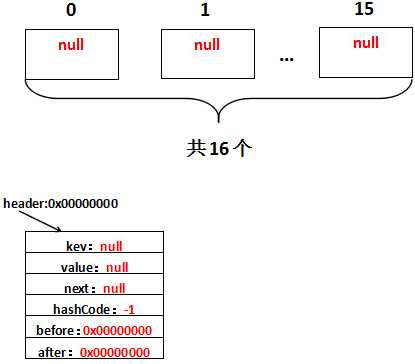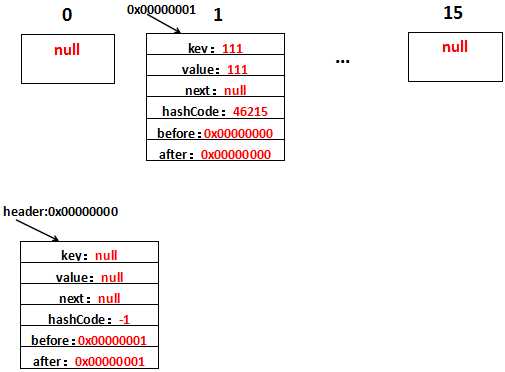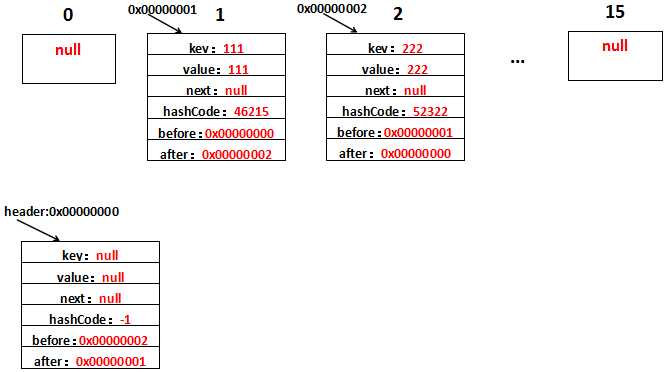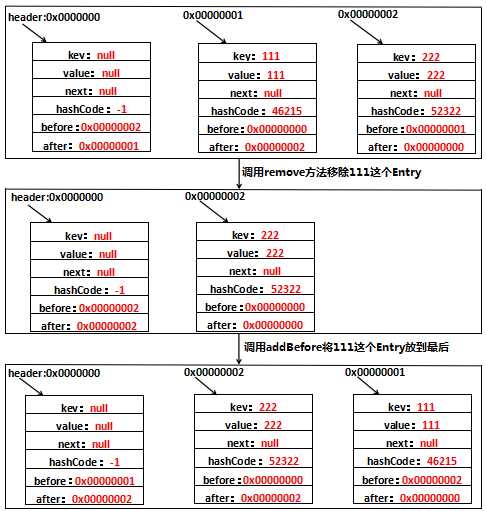标签:resize after ack indent 头结点 做了 class 图表 效果
根据链表中元素的顺序可以分为:按插入顺序的链表,和按访问顺序(调用get方法)的链表。
1 public static void main(String[] args) 2 { 3 LinkedHashMap<String, String> linkedHashMap = 4 new LinkedHashMap<String, String>(); 5 linkedHashMap.put("111", "111"); 6 linkedHashMap.put("222", "222"); 7 }
首先是第3行~第4行,new一个LinkedHashMap出来,看一下做了什么:
通过源代码可以看出,在LinkedHashMap的构造方法中,实际调用了父类HashMap的相关构造方法来构造一个底层存放的table数组。
1 public LinkedHashMap() { 2 super(); 3 accessOrder = false; 4 }
1 public HashMap() { 2 this.loadFactor = DEFAULT_LOAD_FACTOR; 3 threshold = (int)(DEFAULT_INITIAL_CAPACITY * DEFAULT_LOAD_FACTOR); 4 table = new Entry[DEFAULT_INITIAL_CAPACITY]; 5 init(); 6 }
我们已经知道LinkedHashMap的Entry元素继承HashMap的Entry,提供了双向链表的功能。在上述HashMap的构造器中,最后会调用init()方法,进行相关的初始化,这个方法在HashMap的实现中并无意义,只是提供给子类实现相关的初始化调用。
LinkedHashMap重写了init()方法,在调用父类的构造方法完成构造后,进一步实现了对其元素Entry的初始化操作。
1 void init() { 2 header = new Entry<K,V>(-1, null, null, null); 3 header.before = header.after = header; 4 }
这里出现了第一个多态:init()方法。尽管init()方法定义在HashMap中,但是由于:
1、LinkedHashMap重写了init方法
2、实例化出来的是LinkedHashMap
因此实际调用的init方法是LinkedHashMap重写的init方法。假设header的地址是0x00000000,那么初始化完毕,实际上是这样的:

注意这个header,hash值为-1,其他都为null,也就是说这个header不放在数组中,就是用来指示开始元素和标志结束元素的。
header的目的是为了记录第一个插入的元素是谁,在遍历的时候能够找到第一个元素。
五、LinkedHashMap存储元素
LinkedHashMap并未重写父类HashMap的put方法,而是重写了父类HashMap的put方法调用的子方法void recordAccess(HashMap m) ,void addEntry(int hash, K key, V value, int bucketIndex) 和void createEntry(int hash, K key, V value, int bucketIndex),提供了自己特有的双向链接列表的实现。
继续看LinkedHashMap存储元素,也就是put("111","111")做了什么,首先当然是调用HashMap的put方法:
1 //这个方法应该挺熟悉的,如果看了HashMap的解析的话 2 public V put(K key, V value) { 3 //key为null的情况 4 if (key == null) 5 return putForNullKey(value); 6 //通过key算hash,进而算出在数组中的位置,也就是在第几个桶中 7 int hash = hash(key.hashCode()); 8 int i = indexFor(hash, table.length); 9 //查看桶中是否有相同的key值,如果有就直接用新值替换旧值,而不用再创建新的entry了10 for (Entry<K,V> e = table[i]; e != null; e = e.next) { 11 Object k; 12 if (e.hash == hash && ((k = e.key) == key || key.equals(k))) { 13 V oldValue = e.value; 14 e.value = value; 15 e.recordAccess(this); 16 return oldValue; 17 } 18 } 19 20 modCount++; 21 //上面度是熟悉的东西,最重要的地方来了,就是这个方法,LinkedHashMap执行到这里,addEntry()方法不会执行HashMap中的方法, 22 //而是执行自己类中的addEntry方法,23 addEntry(hash, key, value, i); 24 return null; 25 }
第23行又是一个多态,因为LinkedHashMap重写了addEntry方法,因此addEntry调用的是LinkedHashMap重写了的方法:
1 void addEntry(int hash, K key, V value, int bucketIndex) { 2 //调用create方法,将新元素以双向链表的的形式加入到映射中 3 createEntry(hash, key, value, bucketIndex); 4 5 // Remove eldest entry if instructed, else grow capacity if appropriate 6 // 删除最近最少使用元素的策略定义 7 Entry<K,V> eldest = header.after; 8 if (removeEldestEntry(eldest)) { 9 removeEntryForKey(eldest.key); 10 } else { 11 if (size >= threshold) 12 resize(2 * table.length); 13 } 14 }
因为LinkedHashMap由于其本身维护了插入的先后顺序,因此LinkedHashMap可以用来做缓存,第7行~第9行是用来支持FIFO算法的,这里暂时不用去关心它。看一下createEntry方法:
1 void createEntry(int hash, K key, V value, int bucketIndex) { 2 HashMap.Entry<K,V> old = table[bucketIndex]; 3 Entry<K,V> e = new Entry<K,V>(hash, key, value, old); 4 table[bucketIndex] = e; 5 //将该节点插入到链表尾部6 e.addBefore(header); 7 size++; 8 }
private void addBefore(Entry<K,V> existingEntry) { after = existingEntry; before = existingEntry.before; before.after = this; after.before = this; }
createEntry(int hash,K key,V value,int bucketIndex)方法覆盖了父类HashMap中的方法。这个方法不会拓展table数组的大小。该方法首先保留table中bucketIndex处的节点,然后调用Entry的构造方法(将调用到父类HashMap.Entry的构造方法)添加一个节点,即将当前节点的next引用指向table[bucketIndex] 的节点,之后调用的e.addBefore(header)是修改链表,将e节点添加到header节点之前。
第2行~第4行的代码和HashMap没有什么不同,新添加的元素放在table[i]上,差别在于LinkedHashMap还做了addBefore操作,这四行代码的意思就是让新的Entry和原链表生成一个双向链表。假设字符串111放在位置table[1]上,生成的Entry地址为0x00000001,那么用图表示是这样的:

如果熟悉LinkedList的源码应该不难理解,还是解释一下,注意下existingEntry表示的是header:
1、after=existingEntry,即新增的Entry的after=header地址,即after=0x00000000
2、before=existingEntry.before,即新增的Entry的before是header的before的地址,header的before此时是0x00000000,因此新增的Entry的before=0x00000000
3、before.after=this,新增的Entry的before此时为0x00000000即header,header的after=this,即header的after=0x00000001
4、after.before=this,新增的Entry的after此时为0x00000000即header,header的before=this,即header的before=0x00000001
这样,header与新增的Entry的一个双向链表就形成了。再看,新增了字符串222之后是什么样的,假设新增的Entry的地址为0x00000002,生成到table[2]上,用图表示是这样的:

就不细解释了,只要before、after清除地知道代表的是哪个Entry的就不会有什么问题。
注意,这里的插入有两重含义:
1.从table的角度看,新的entry需要插入到对应的bucket里,当有哈希冲突时,采用头插法将新的entry插入到冲突链表的头部。
2.从header的角度看,新的entry需要插入到双向链表的尾部。
3、LinkedHashMap读取元素
LinkedHashMap重写了父类HashMap的get方法,实际在调用父类getEntry()方法取得查找的元素后,再判断当排序模式accessOrder为true时(即按访问顺序排序),先将当前节点从链表中移除,然后再将当前节点插入到链表尾部。由于的链表的增加、删除操作是常量级的,故并不会带来性能的损失。
/** * 通过key获取value,与HashMap的区别是:当LinkedHashMap按访问顺序排序的时候,会将访问的当前节点移到链表尾部(头结点的前一个节点) */public V get(Object key) { // 调用父类HashMap的getEntry()方法,取得要查找的元素。 Entry<K,V> e = (Entry<K,V>)getEntry(key); if (e == null) return null; // 记录访问顺序。 e.recordAccess(this); return e.value; }
/** * 在HashMap的put和get方法中,会调用该方法,在HashMap中该方法为空 * 在LinkedHashMap中,当按访问顺序排序时,该方法会将当前节点插入到链表尾部(头结点的前一个节点),否则不做任何事 */void recordAccess(HashMap<K,V> m) { LinkedHashMap<K,V> lm = (LinkedHashMap<K,V>)m; //当LinkedHashMap按访问排序时 if (lm.accessOrder) { lm.modCount++; //移除当前节点 remove(); //将当前节点插入到头结点前面 addBefore(lm.header); } }
private void addBefore(Entry<K,V> existingEntry) {
after = existingEntry;
before = existingEntry.before;
before.after = this;
after.before = this;
}
4、利用LinkedHashMap实现LRU算法缓存
前面讲了LinkedHashMap添加元素,删除、修改元素就不说了,比较简单,和HashMap+LinkedList的删除、修改元素大同小异,下面讲一个新的内容。
LinkedHashMap可以用来作缓存,比方说LRUCache,看一下这个类的代码,很简单,就十几行而已:
public class LRUCache extends LinkedHashMap { public LRUCache(int maxSize) { super(maxSize, 0.75F, true); maxElements = maxSize; } protected boolean removeEldestEntry(java.util.Map.Entry eldest) { return size() > maxElements; } private static final long serialVersionUID = 1L; protected int maxElements; }
顾名思义,LRUCache就是基于LRU算法的Cache(缓存),这个类继承自LinkedHashMap,而类中看到没有什么特别的方法,这说明LRUCache实现缓存LRU功能都是源自LinkedHashMap的。LinkedHashMap可以实现LRU算法的缓存基于两点:
1、LinkedList首先它是一个Map,Map是基于K-V的,和缓存一致
2、LinkedList提供了一个boolean值可以让用户指定是否实现LRU
那么,首先我们了解一下什么是LRU:LRU即Least Recently Used,最近最少使用,也就是说,当缓存满了,会优先淘汰那些最近最不常访问的数据。比方说数据a,1天前访问了;数据b,2天前访问了,缓存满了,优先会淘汰数据b。
我们看一下LinkedList带boolean型参数的构造方法:
public LinkedHashMap(int initialCapacity, float loadFactor, boolean accessOrder) { super(initialCapacity, loadFactor); this.accessOrder = accessOrder; }
就是这个accessOrder,它表示:
(1)false,所有的Entry按照插入的顺序排列
(2)true,所有的Entry按照访问的顺序排列
第二点的意思就是,如果有1 2 3这3个Entry,那么访问了1,就把1移到尾部去,即2 3 1。每次访问都把访问的那个数据移到双向队列的尾部去,那么每次要淘汰数据的时候,双向队列最头的那个数据不就是最不常访问的那个数据了吗?换句话说,双向链表最头的那个数据就是要淘汰的数据。
"访问",这个词有两层意思:
1、根据Key拿到Value,也就是get方法
2、修改Key对应的Value,也就是put方法
首先看一下get方法,它在LinkedHashMap中被重写:
public V get(Object key) { Entry<K,V> e = (Entry<K,V>)getEntry(key); if (e == null) return null; e.recordAccess(this); return e.value; }
然后是put方法,沿用父类HashMap的:
1 public V put(K key, V value) { 2 if (key == null) 3 return putForNullKey(value); 4 int hash = hash(key.hashCode()); 5 int i = indexFor(hash, table.length); 6 for (Entry<K,V> e = table[i]; e != null; e = e.next) { 7 Object k; 8 if (e.hash == hash && ((k = e.key) == key || key.equals(k))) { 9 V oldValue = e.value; 10 e.value = value; 11 e.recordAccess(this); 12 return oldValue; 13 } 14 } 15 16 modCount++; 17 addEntry(hash, key, value, i); 18 return null; 19 }
修改数据也就是第6行~第14行的代码。看到两端代码都有一个共同点:都调用了recordAccess方法,且这个方法是Entry中的方法,也就是说每次的recordAccess操作的都是某一个固定的Entry。
recordAccess,顾名思义,记录访问,也就是说你这次访问了双向链表,我就把你记录下来,怎么记录?把你访问的Entry移到尾部去。这个方法在HashMap中是一个空方法,就是用来给子类记录访问用的,看一下LinkedHashMap中的实现:
void recordAccess(HashMap<K,V> m) { LinkedHashMap<K,V> lm = (LinkedHashMap<K,V>)m; if (lm.accessOrder) { lm.modCount++; remove(); addBefore(lm.header); } }
private void remove() { before.after = after; after.before = before; }
private void addBefore(Entry<K,V> existingEntry) { after = existingEntry; before = existingEntry.before; before.after = this; after.before = this; }
看到每次recordAccess的时候做了两件事情:
1、把待移动的Entry的前后Entry相连
2、把待移动的Entry移动到尾部
当然,这一切都是基于accessOrder=true的情况下。最后用一张图表示一下整个recordAccess的过程吧:

void recordAccess(HashMap<K,V> m) 这个方法就是我们一开始说的,accessOrder为true时,就是使用的访问顺序,访问次数最少到访问次数最多,此时要做特殊处理。处理机制就是访问了一次,就将自己往后移一位,这里就是先将自己删除了,然后在把自己添加,这样,近期访问的少的就在链表的开始,最近访问的元素就会在链表的末尾。如果为false。那么默认就是插入顺序,直接通过链表的特点就能依次找到插入元素,不用做特殊处理。
5、代码演示LinkedHashMap按照访问顺序排序的效果
最后代码演示一下LinkedList按照访问顺序排序的效果,验证一下上一部分LinkedHashMap的LRU功能:
public static void main(String[] args) { LinkedHashMap<String, String> linkedHashMap = new LinkedHashMap<String, String>(16, 0.75f, true); linkedHashMap.put("111", "111"); linkedHashMap.put("222", "222"); linkedHashMap.put("333", "333"); linkedHashMap.put("444", "444"); loopLinkedHashMap(linkedHashMap); linkedHashMap.get("111"); loopLinkedHashMap(linkedHashMap); linkedHashMap.put("222", "2222"); loopLinkedHashMap(linkedHashMap); } public static void loopLinkedHashMap(LinkedHashMap<String, String> linkedHashMap) { Set<Map.Entry<String, String>> set = inkedHashMap.entrySet(); Iterator<Map.Entry<String, String>> iterator = set.iterator(); while (iterator.hasNext()) { System.out.print(iterator.next() + "\t"); } System.out.println(); }
注意这里的构造方法要用三个参数那个且最后的要传入true,这样才表示按照访问顺序排序。看一下代码运行结果:
111=111 222=222 333=333 444=444 222=222 333=333 444=444 111=111 333=333 444=444 111=111 222=2222
代码运行结果证明了两点:
1、LinkedList是有序的
标签:resize after ack indent 头结点 做了 class 图表 效果
原文地址:http://www.cnblogs.com/wang-meng/p/7583491.html